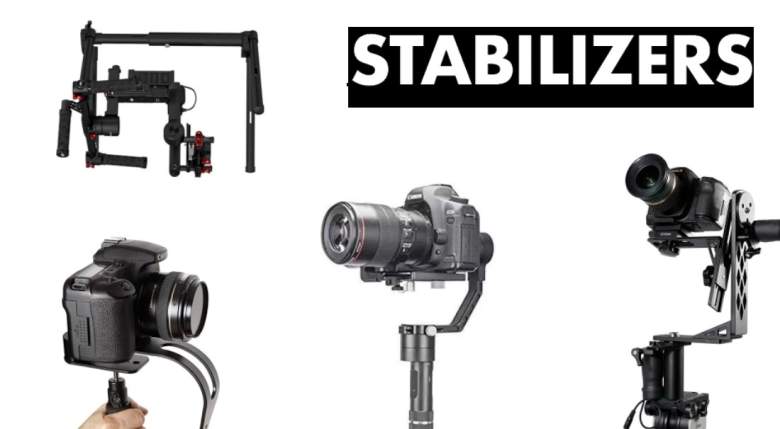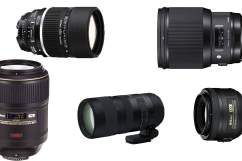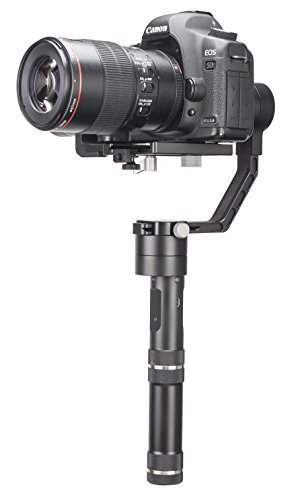
Buying a stabilizer for your DSLR is a great way to take your footage to the next level. Long tracking shots, elaborate pans and zooms, and in general, a more professional look and feel are some great advantages that stabilizers provide. There are two kinds of stabilizers: weight-based and gimbal. We’ve included one affordable weight-based stabilizer on this list. While these stabilizers can be cheap, there are some expensive high-quality versions (such as the Glidecam, see on Amazon). At this time, however, unless one needs utter silence from their stabilizer, electronic gimbal stabilizers offer the best value and therefore make up the other four items on this list.
Some factors to consider when buying a stabilizer are price, sound, and balancing. Given that just a few years ago, stabilizers like the Ronin (the most expensive stabilizer on our list) were considerably more expensive, gimabls are a great deal. As far as sound, The Roxant Pro (1 on our list) is the most quiet stabilizer since it has no moving parts, but for the most part, all but the Movo stabilizer are on the quiet side. Balancing is the number one consideration. Be sure that the lens and camera you wish to shoot with fit within the weight capacity of the camera. In general, long lenses tend to cause issues so be prepared to compromise to shorter or medium lenses. Not all of the gimbals on this list work with all cameras, but generally speaking, any DSLR and medium or short lens should work, certainly within the top three video DSLRs and mirrorless cameras (A7S II, GH5, and 5DMK4), these gimbals have enough weight capacity. Other cameras like t6is, Nikons, and small Sony’s (A6000) should work with all of these stabilizers.
One final note about balancing. Disappointment is when expectation doesn’t meet reality so expect this: it will take time to learn how to balance your stabilizer. Once you learn the process, it will still take between five to ten minutes to execute each time you use the stabilizer, depending on the complexity of the model. Considering that stabilizers like this were much more expensive and hard to use even five years ago, an hour or two of learning is a bargain for the added quality to your footage.
With all of that in mind, here’s the top 5 best DSLR stabilizers from lowest to highest price.
1. Roxant Pro Handheld Stabilizer
Weight 2.1lbs | Weight Capacity 1.8lbs | Mounting Options Standard mount | Battery Life N/A | Warranty Lifetime support |
Great as a stand-alone stabilizer or as an add-on to one’s stabilizer arsenal, the Roxant Pro is loved by reviewers on Amazon, corporate video shooters, and professionals.
While this stabilizer offers great value and high quality footage, don’t be fooled by the bargain: it is a professional tool and therefore requires calibration and balancing. Still, once set-up, many users attest to a leap in footage quality and at only $65, it’s a hard price to say no to.
One of the biggest advantages of this stabilizer is that Roxant is repeatedly praised for its excellent and attentive customer service. Tim Ford, professional videographers, writes that upon ordering this product, he was immediately emailed and sent a replacement handle which he preferred to the included one (see his website).
One consideration to keep in mind with the Roxant Pro is that many users suggest that in order to achieve max performance, one must “hack” the device (see comment thread on Amazon). This includes mounting additional weights to the stabilizer (heavy washers) as far from the axis as possible.
While it may require some tweaking, the Roxant Pro is an affordable and solid solution. It swings far above its price, but for those who want something a bit more advanced, robust and smooth, it may not be the best option. It’s great a supplemental tool or for the filmmaker on a budget. While its mechanical simplicity belies how it can be difficult to use, it’s certainly not the hardest gimbal to set up on this list and at this price, one can save money and a fair amount of time.
Price: $64.95
Buy the Roxant Pro Handheld Stabilizer here.
Pros:
- Compatible with virtually all cameras under two pounds
- Roxant offers great support, product has impeccable reviews on Amazon
- Cheap and effective solution
- Many users achieved great footage with some practice
- Works with cameras as small as GoPro, up to medium DSLRs
Cons:
- Learning curve means it takes time to get good with it
- Some users required configuration and tweaking to make stabilizing easier
- A small percentage of users had durability issues
- Included instructions can be unclear, but Roxant does provide training videos
- Uses weights for stabilization; can get straining
Find more Roxant Pro Handheld Stabilizer information and reviews here.
2. Movo MGB-5 (Panning and tilting tripod head)
Weight 9.1lbs | Weight Capacity 11lbs | Mounting Options Quick release plate | Battery Life Plugs in | Warranty 1 year with USA-based support
The Movo MGB-5 is a unique option that offers smooth pans, tilts, and a high-quality remote control. Calling it a gimbal is a bit of a misnomer, but it certainly achieves many of the same shots that gimbals do: liquid smooth tilts and pans. That said, it is not built to walk around with or stabilize live movement. It takes very smooth shots while mounted on a tripod using a relatively loud motor, another issue for some shooters; you won’t be able to use on-camera sound.
The Movo MGB-5 is best for those who want durability because it’s not a delicate device. Unlike the other electronic gimbals on this list, which can get drifty and uncalibrated, the Movo is a rock solid heavy duty piece of gear. It doesn’t have microprocessors balancing your camera live, it’s just a lot of metal that moves smoothly. It’s not for everyone, but it is very practical and the simplest stabilizer to set up and use on this list.
Users are blown away by the footage quality, remote control, and say it’s a top notch fit for indie and low budget filmmaking. It’s not nearly the catch-all solution a three-axis gimbal is, but at a lower price and simpler setup, it may be a better choice for some users. It’s best when shooting wide-angle shots at a distance. If this is your primary shot type, this stabilizer will give you great results and longevity at a great price.
Price: $349.95 (27 percent off MSRP)
Buy the Movo MGB-5 here.
Great for nature shots and similar footage on a budget. The noisy motor may be a dealbreaker for those who demand utmost silence.
Pros:
- High quality remote control praised as heavy-duty as a guitar pedal allows for different speeds
- Praised as very well made and sturdy
- Loudness of motor said to be an overstated problem; does not interfere with most users’ footage using external microphones
- Movements are liquid smooth
- Good deal for indie filmmaking
- Includes high quality remote controller with adjustable speed & carrying case
Cons:
- Motor can on the noisy side
- One user felt that the stabilizer couldn’t go slow enough for his needs, another felt it it couldn’t go fast enough
- Can be jerky with sudden movements
- One user had to purchase a portable power bank to be able to use for long durations
- Uses AC power, will need a power pack or generator to use when not near power
- Best for wide shots; slow pans of close-ups and mid-shots are wonky
Find more Movo MGB-5 information and reviews here.
3. Zhiyun Crane V2 3-Axis Handheld Stabilizer (Editor’s Choice)
Weight 2.1lb | Weight Capacity 1800 grams (after firmware update) | Mounting Options Standard tripod thumbscrew | Battery Life 12 hours (with two included batteries) | Warranty 1 year manufacturer’s warranty | Three operation modes: pan and follow, locking, pan and tilt follow
While DJI remains the undisputed monopoly dominating the drone market in terms of quality and sales, the same cannot be said of gimbals. Zhiyun has showed itself to be a worthy competitor both in terms of price, quality, and product differentiation. Zhiyun’s Crane is great for DSLRs and boasts a much smaller profile than a Ronin-M. It’s also considerably cheaper.
Users praise it for its easier setup time, simplicity in a tool-less design, and a battery that now lasts between 10 to 12 hours. The Zhiyun also can be now be mounted directly to a tripod. For Sony shooters, one can buy a cable (see on Amazon) that lets the Zhiyun control parameters through its new robust camera control panel. That said, do not buy the Zhiyun for this feature; many users had issues with it in terms of reliability. For an extra $25, however, it is a nice bonus if one can get it to work.
The Zhiyun is the editor’s choice because it boasts simplicity, robust capabilities, and it’s affordable at a great price point. Sure, the gimbals below have advantages, but for the vast majority of users, the Zhiyun will get the job done. That said, it is not advised for people who want to shoot using long, heavy lenses. The weight capacity can handle a 5dMk4, but not that same camera with a huge L series lens. It’s something to be aware of, but for most people, this gimbal will meet your needs and more.
The Zhiyun delivers on all of the expectations of a gimbal: challenging but not overly difficult balancing, smooth walking shots, smooth panning, tilting and movement, and a small, ergonomic form factor. It’s great.
Price: $549
Buy the Zhiyun Crane V2 3-Axis Handheld Stabilizer here.
Shot with 5D mk4 and 24-70f4 (Note: The Zhiyun firmware must be upgraded to hold higher payloads of up to 1800 grams)
Pros:
- Easy and small form factor
- Offers 360 degree rotation along all three axes
- Can be controlled via Bluetooth with included iOS/Android app
- Easier to setup than a Ronin
- Can be configured to control shutter speed and other parameters on Sony cameras (see YouTube video)
- Includes compact hard case
Cons:
- Will not be able to carry big lenses due to weight limitations
- Gimbal design can block screen from full viewing
- Lack of a quick release plate means mount and dismounting slow
- Some jitters are noticeable when walking for instance
Find more Zhiyun Crane V2 3-Axis Handheld Stabilizer information and reviews here.
4. Glide Gear Geranos VII Gimbal Stabilizer
Weight 2lbs | Weight Capacity 2.6lbs | Mounting Options Standard tripod mount | Battery Life 12 hours (includes two batteries) | Warranty Limited lifetime warranty |
The Geranos VII is very similar to the Zhiyun Crane (and even uses a similar app), but offers a unique advantage: US-based company and support. Reviewers suggest that it is easy to use and setup. The technology (motors and preliminary design) are provided by Zhiyun, but the warranty and support is provided by US-based Glide Gear who is even offering a lifetime limited warranty. Many who have had issues with gear, dealing with overseas fulfillment of warranties can be pricey (shipping) and annoying (phone call after phone call). Therefore, this stabilizer offers huge benefit for the small percentage of users who fear that they may have problems with their unit.
Compared to the Ronin-M, which becomes an event anytime one needs to set up their gear, Tomas Villegas says this can be done in a fraction of time on the Geranos. It disassembles into three parts and is easy to put together. It’s not effortless to set-up, but it is comparable to the Zhiyun, and certainly an easier process than the Ronin-M.
If having US-based support is a must for you, the Glide Gear is a choice very comparable to the Zhiyun and is bound to please many users for a lifetime (limited lifetime warranty, but it is not explained thoroughly on Glide Gear’s website).
Price: $699
Buy the Glide Gear Geranos VII Gimbal Stabilizer here.
Pros:
- Same great features of Zhiyun Crane but from a US distributor
- LImited lifetime warranty backed up by US company
- Much simpler than a Ronin-M for setup
- Great battery life, 2 batteries at six hours each
- Users who received faulty units received replacements
Cons:
- One user had an issue with customer service
- No quick release plate
- Some jittering is noticeable, not as smooth as Ronin
- Screen is blocked by design of gimbal
Find more Glide Gear Geranos VII Gimbal Stabilizer information and reviews here.
5. DJI Ronin-M 3-Axis Gimbal Stabilizer (Any DSLR, mirrorless, or light cinema camera)
Weight 5.1lbs | Weight Capacity 9lbs (Users report 8lbs) | Mounting Options Follow focus, Matte boxes can be mounted on industry standard dual 15mm segmented rods | Battery Life Six hours, with intelligent battery | Receiver 2.4ghz | Accessories Follow focus from DJI | Warranty 6-12 months depending on the part (view warranty on mnfg website) |
While the Zhiyun Crane V2 beats the Ronin-M for quick practical shoots and a sizable portion of indie filmmakers, there’s a reason the Ronin-M still dominates the market: it is an extremely robust professional tool. Right off the bat, the Ronin-M can hold much heavier lens/camera combinations, including professional cinema cameras like the Canon C-Series or even an Alexa Mini.
The Ronin-M includes a remote control meaning it’s great for having one operator move the gimbal while another operator steers it remotely. This is that professional panning while moving look that is the mark of high budget commercial production and Hollywood filmmaking; this cannot be achieved on a Zhiyun Crane or any of the other stabilizers on this list.
Another particularly cool shot type that is also unique to the Ronin-M is passing the apparatus through barriers, given its bulky size, this is easy to do.
The Ronin-M is a professional tool and it gives professional results. It includes DJI’s app which lets one do automated pans, adjust settings, and helps with calibration and balancing. This, however, is where the issues start: the Ronin-M is also a tool that requires professional setup time and attention. Due to its large size, it’s not really a “Grab it and go” kind of device. For many, its features will be vastly overkill. This is a gimbal that requires balancing, calibration, and high frustration tolerance.
All that said, it’s a great value considering the kind of shots one can get and the complexity of the footage it can capture. It’s the new indie filmmaking standard for a reason: it’s the best. Just don’t buy it unless you’re ready to maintain and set-up a professional tool, each and every time you need to use your stabilizer.
Price: $979
Buy the DJI Ronin-M 3-Axis Gimbal Stabilizer (Any DSLR, mirrorless, or light cinema camera) here.
Pros:
- Can handle any DSLR and/or small cinema cameras
- Allows for many unique types of shots, including being passed through doors, windows, and other barriers
- Quiet with easy setup
- Footage consistently looks smooth
- Includes RC controller so second operator can adjust pan, tilt, and roll
- No tools necessary for balancing
Cons:
- Balancing is time-consuming and takes practice
- Can be very hard to balance with heavier rigs (FS5 with long lens)
- Drifting can be a problem
- One user reported an issue with the bars loosening https://www.videomaker.com/article/r02/18229-dji-ronin-m-field-review
Find more DJI Ronin-M 3-Axis Gimbal Stabilizer (Any DSLR, mirrorless, or light cinema camera) information and reviews here.





